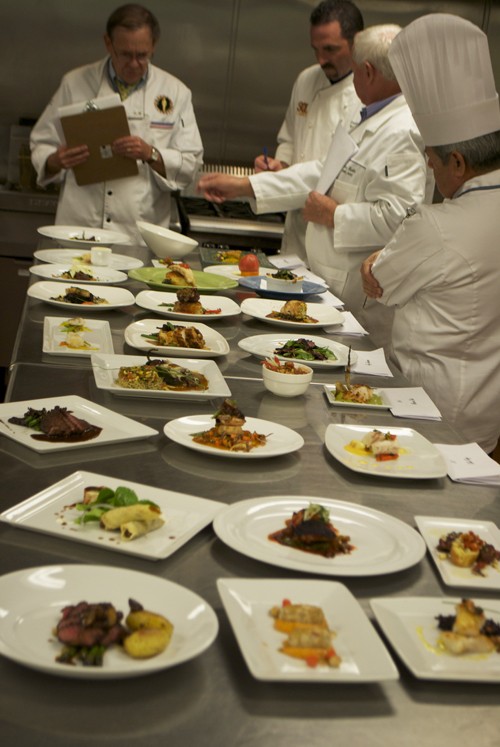There was a flurry of activity on Saturday at the Art Institute of Tucson, where the American Culinary Federation hosted the Chef of the Year Culinary Competition.
Nine executive chefs from various restaurants in Tucson competed for the local title, which, according to competition host Todd Eanes “”is a resume builder”” for local chefs looking to gain recognition. Each chef had three hours to prepare, cook and plate a three-course meal. In order to qualify for the competition, the contestants had to hold the equivalent of a sous chef title or higher in a full-service dining operation and be current members of the American Culinary Federation. After selecting ingredients from a table groaning under the weight of fresh produce, spices, herbs, oils and vinegars, the contestants created a menu and presented it to judges Walter Leible, Garry Waldie, Juan Martinez and Al Zeman. They were not allowed to modify their choices, and as an added challenge, a mystery ingredient had to be included in their menu. Each of the nine contestants had an assistant chosen from the best culinary students at the Art Institute of Tucson. Some 10 percent of the students attending the Art Institute are former UA students.
Jason Jonilonis of Sol Casinos began at 8 a.m., and at 8:30 a.m. Ken Harvey of Loews Ventana Canyon Resort began to prepare his three-course meal. It went until noon when final contestant Ryan Clark of Lodge on the Desert began his assembly. This allowed enough time and space in the kitchen for both contestants and judges to operate. Six portions of each meal were prepared and plated: one submitted to the judges for tasting, one to be used for display and four portions offered for dining experience.
Each chef wore a uniform as stipulated by the guidelines in the competition.
“”These uniforms are traditional and functional,”” said Elizabeth Mikesell, vice president of the ACF Chefs Association of Southern Arizona.
They are white and double breasted, meaning that they can be re-buttoned to hide food stains. Checkered pants are worn to hide dirt. “”Patterned pants are new, not traditional,”” Mikesell said.
Clogs are also worn, not only to combat slippery floors but also so they can be removed quickly if necessary. A toque — the tall hat most chefs wear — is also part of the uniform; its height determines your rank in the kitchen.
Competitors were also judged on sanitation, cooking techniques, portion size and nutritional balance, creativity and ingredient compatibility, flavor, taste and texture as well as presentation.
“”Plating is my favorite part,”” said Jessica Gandara, a culinary arts student at the Art Institute of Tucson. “”It puts a touch of you on the plate.””
In all, the food was spectacularly presented with bold flavors and subtle artistic touches. However, there was a fair amount of ego simmering in the kitchen and, needless to say, the criteria and point system are not as straightforward and simple as one might think; even the richest dish can be considered mundane by a master chef.
The winner of the competition will be announced at the next American Culinary Federation meeting on Dec. 11.









